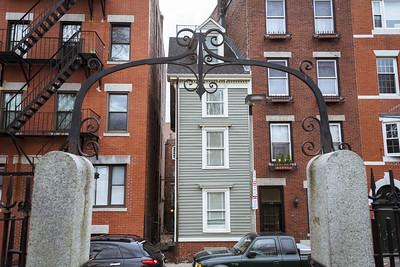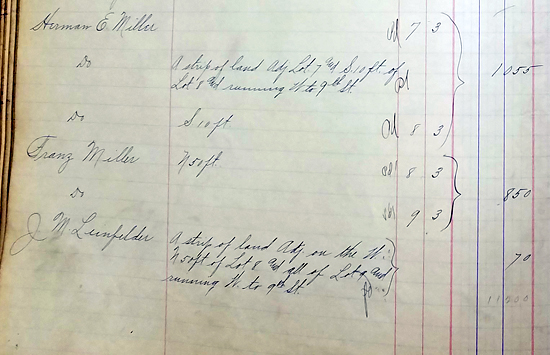
The Spite Fence
(written by Jenny DeRocher and Dave Kranz; research and images compiled by Dave Kranz)
Pettiness is part of human nature. And sometimes pettiness takes the form of an object or structure that lasts through time. Today, we get to see traces of our history — like a fading sign on the side of a historic building, or someone’s name carved in the cement in a basement — and from these remnants, we see that evidence of our own actions lasts through time. We have to ask ourselves: how do we want to be remembered? Let’s take a look at a story that took place at the northeast corner of 9th & Market Streets to remind ourselves that treating our neighbors with kindness and love is always the answer.
“Spite houses” are a well-known phenomenon. There is even a Wikipedia page that lists examples of spite houses built in the U.S.

According to legend, this 10-foot-wide home was built in Boston as a spite house to block sunlight from the house next door. However, this history is not well-documented and the true story of this narrow home can only be speculated. Photo courtesy of Scott D on Flickr.
In La Crosse, we don’t know of any homes that were built in spiteful acts of revenge, but we do have the story of Frank Hoeschler’s spite fence. This story is well-documented, thanks to newspaper articles, maps, and court records. The details can get a little confusing, but visual aids like maps can help us understand this story.
In 1870, a man named Joseph Leinfelder bought three plots of land at the northeast corner of 9th & Market. These three lots had been platted in a mysterious way, with a thin, triangular piece of land running across the front of the three lots:

As you can see in this 1898 City Atlas (page 19), the triangle was 16 feet wide at the base (north) on Lot 9, ran across Lot 8, and tapered off to 6 feet near the point (south) on Lot 7.
According to La Crosse Tribune articles from 1906-1907, written by various individuals, Joseph Leinfelder gardened on this triangular piece of land in front of the plots, and later just used it as a front yard for the homes. It didn’t cause any problems until after his 1891 death, when the three lots were split between his relatives:
- Lot 9 and the northern part of Lot 8 were left to his 21-year-old son, Frank X. Leinfelder.
- Lot 7 and the southern part of Lot 8 were left to other relatives.
Leinfelder's will also had a clause that specified any property not mentioned in the will was to be left to his children.
When Frank X. Leinfelder took possession of the property, he rented it out as his father had in later years. In 1899, Frank used the property as collateral to get a $900 mortgage loan from a man named Franz Miller. It is uncertain what the relationship of these two men were before this loan, how they knew one another, or why Miller gave Leinfelder the loan. During this transaction, no mention was made of the strip of land between the house and the street. A few years later, Frank X. Leinfelder failed to pay on his loan and the property was foreclosed upon. In 1902, Franz Miller took ownership of Lot 9 and the northern part of Lot 8. Miller continued to use the property as a rental.
Franz Miller was listed as the owner of the three lots in the 1902 City of La Crosse tax ledger. This ledger also lists the odd strip of land, and listed Joseph Leinfelder as the owner (though deceased). Hoeschler paid the taxes owed on the strip of land, and signed the book on the following page (click image to see full photograph). Photo by Dave Kranz.
The Leinfelder family were upset, whether it was Miller’s treatment of Frank X. Leinfelder, or the fact that their father’s property was no longer in the family. Frank J. Hoeschler, brother-in-law to Frank X. Leinfelder, somehow learned about the triangular strip of land around this time, and started making moves to ensure it stayed in the family. Hoeschler got a banker and convinced the Leinfelder heirs to sign a quit-claim deed to the strip of land. Then Hoeschler purchased the piece of land for $1.
Hoeschler went to Franz Miller with an ultimatum: either Miller could purchase the small strip of land for a large sum — one report claims $500 and another $1000 — or Hoeschler would erect a fence on the land, which would effectively block the house on lots 9 and 8 from street access. Miller refused to pay, and challenged Hoeschler’s threat.
In May 1903, Hoeschler had a wire fence put up around his triangular strip of property. Miller promptly took the fence down. Hoeschler erected another fence, and this time he built a large, wooden fence and called it a “billboard.” On it, he painted an advertisement for his dentist office. In response, Miller brought Hoeschler to court on charges of contempt.
La Crosse Tribune, December 22, 1906, page 1. Click on image to read full article.
The case went to the Wisconsin Supreme Court on appeal two times. In 1904, the question was whether Miller had to file suit again each time Hoeschler built a fence. In 1905, the question became whether Miller had to be granted a way to access the street from his own land over Hoeschler’s property. Both times, the court sided with Hoeschler, but did grant that an opening in the fence must be made for occupants of the home to have street access.
La Crosse Tribune, September 5, 1907, page 5. Click on image to read full article.
The Tribune articles seem to side with Miller — taking pity on an older man being bullied by the young Hoeschler — and it seems that most of the community did, too. On Halloween night in 1907, vigilante teenage boys destroyed the fence. The paper’s headline was, “Boys Do What Court Failed to Accomplish—Neighbors are Tickled.”
La Crosse Tribune, November 1, 1907, page 12. Click on image to read full article.
The boys — listed as Eugene McNeany, Edward Row, John Row, and George Lapitz — were fined $1 and costs, which in the end was $3.50 each for the “malicious destruction of property.” It seems that Hoeschler and Miller left it at that.
Today, a parking lot occupies these lots.




